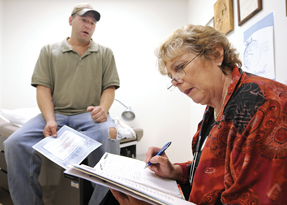Options to secure e-mails
Numerous options are available to make e-mail communications to patients more secure.
E-mail is a “double-edged sword.” On the one hand, it can be a wonderful thing both in personal communication and in practice. And, it is convenient and efficient. On the other hand, controlling it and using it appropriately take some skill. Now that e-mail is ubiquitous, patients more and more want to use it to communicate with their physicians.
Despite the popularity of e-mail, there is still much hesitancy about using it routinely as part of clinical care. Communicating electronically has some obvious risks, such as online malpractice exposure and inappropriate disclosure of confidential patient information. Fear of non-compliance with the Health Insurance Portability and Accountability Act is a major barrier for physician use of e-mail. While medical practices are not specifically required to protect patient-physician e-communications as long as patients understand the risk, nevertheless it is prudent to use some sort of secure communication tool to avoid inappropriate disclosure of personal health information.
But there are many good reasons to use e-mail in practice, both with patients as well as with other clinicians or facilities. Besides increasing patient satisfaction, and therefore engagement and retention, some health care organizations encourage use of e-mail as a way to manage non-urgent conditions without bringing patients into expensive emergency or acute care facilities. From the practice standpoint, e-mail can reduce phone calls as well as visits, which saves time for both the physician and staff. And, in addition to meeting growing expectations for quick and precise information exchange, e-mail can inform and educate patients, provide automated follow-up, enhance informed consent, facilitate compliance with treatment regimens, and document communication.
While many electronic health records (EHRs) offer patient portals through which secure e-mail is available, the options for setting up secure e-mail for non-EHR practices can be confusing. Google searches yield many results for secure e-mail or encryption solutions, some as part of robust packages that include scheduling, bill payment and form downloads, and others as part of simpler free or low-cost e-mail solutions.
An increasingly popular solution to secure messaging is to use a Web-based portal. In this case, physicians and patients both sign in to a secure website and send messages back and forth within it. These systems allow easy flow of secure encrypted messages with little or no added effort on the part of physician practices or their patients. These portals, or “secure contact forms,” do not require installation on personal computers, and thus are easy for patients. All patients need is Internet access to send and receive secure messages.
Here are some of the numerous options available. It is worth viewing a demo or trying out different solutions to find which will best meet your needs and which might have other features that could work in your practice.
- iMedicor.
- Medfusion and Medem, now Intuit Health.
- Privacy Data Systems.
- Proofpoint.
- RelayHealth.
- Voltage.
- WordSecure.
- ZixMail.
For more information on using secure e-mail, read this blog entry by Alan Brookstone, MD, on the American EHR Partners website. Also, read ACP's guide “Communicating with Patients Electronically.”





